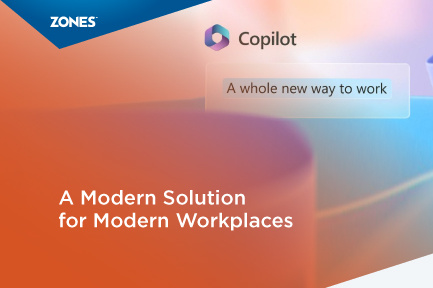Decoding the Employee Experience (EX) Blackbox
“Over 41% of enterprises cite the improvement of employee experience as a top outsourcing objective, emphasizing its pivotal role in the current era...
4 min read
David Martin, Practice Director, Digital Workplace, Zones : Jul 25, 2024 8:53:02 AM

In the past few years, the definition of the workplace has gone beyond the physical location to virtual space. With the shift from fully remote to hybrid work, or in some cases back to in-office work, companies are at a crucial juncture. This shift is a good chance to re-design the digital workplace; at the same time, it has become a major issue when it comes to stability and functioning across contexts.
The term employee experience, or EX, is now the newest strategic direction that many organizations are taking to improve performance and engagement. Catalysts of this effort include the service desk, which is considered by many as the front line of the IT help desk. But it is a little more than just a help desk; it is a tool for forming a working environment that will promote the success of the workers.
Try to picture this: starting your day, and the first thing that meets the eye is a small issue with technology. Instead of having your complaint listened to by rude and unhelpful support personnel and having your issue fixed, you come across a polite service desk, have your issue fixed, and are allowed to continue with your work. This is not only about solving the problems but creating an atmosphere where your effort will be valued.
Nevertheless, it is worth emphasizing that all these changes are taking place with the help of people. It does not matter how much technology advances and develops; people remain the main driving force behind the process. Addressing employees’ needs and adopting new technologies are the strategies that can foster an optimum workplace environment.
At Zones, we believe that empowering modern workstyles with great employee experiences and efficient service desk operations is crucial for the future of the digital workplace. Forrester’s latest report, 'The State of the Service Desk, 2024,’ reveals a significant challenge that only 55% of employees feel fully supported by their service desk. This points to the need for improvement in handling tech issues and addressing resource limitations. In this blog, we will explore the valuable insights and strategies to transform service desk operations, highlighting the critical role of employee experience (EX).
|
“Despite human best efforts, systematic technology failings continue to drain employee experience (EX). This report details how to start overcoming these barriers. The Service Desk and IT in general face not just perpetually high demand, but chronic resource limitations and lack of support for EX considerations in decision-making and purchasing.” - Will McKeon – White, Senior Analyst, Forrester |
EX is a key aspect that forms the basis for the digital workplace. EX has a direct impact on productivity, employee engagement, and subsequent organizational satisfaction. If employees are provided with support and can embrace the technology in their workplace, they will be in a position to share information, respond to change, and deliver superior performance. There is consistently high demand for service desk and IT in general, while resources remain scarce and EX factors are often left out from decision-making and purchasing processes. Surveying is still in its infancy. Less than half of the employees (49%) responded positively to the following statements: “The service desk proactively seeks my feedback,” and 46% to “Changes are made based on feedback.”
The service desk is the central point for handling the problems that end users may experience and can be accessed during technological breakdowns. It is essential for the company’s performance because satisfied workers translate to satisfied clients. Still, many employees fail to find the answers and, as a result, they do not turn to the service desk at all. This is especially the case where organizations have a poor EX or where employees lack the correct technology and support from the IT department to ensure that customers are satisfied.
The service desk transformation is crucial for improving operational performance and achieving a better EX. It is also the ability to solve problems and, even better, avoid them before they occur, thereby increasing efficiency and user satisfaction. It is also crucial to ensure that employees are constantly trained and developed as more devices and applications are introduced into the workplace. These measures can also be seen as a proactive approach to guaranteeing a satisfactory and efficient work environment for all those involved.
Engage service desk users and map the complete employee journey, as many organizations rely only on post-event surveying and may not record the experiences of those who avoid using the service desk.
Explain why some organizations have reluctant employees so that there can be a better understanding of how to tackle and rectify those experience gaps.
Develop internal IT talent—tenure is undervalued
Take advantage of experienced IT workers' knowledge about organizational behaviors to identify gaps and recruit experienced talent.
Provide a clear career path and sponsor certifications, particularly during skills deficits, to ensure that employees acquire and retain the best talent.
Allow employees to reset passwords using self-service solutions like catalog entries or chatbots, as 66% of employees find it convenient to use this approach rather than rely on support officers.
Minimize the number of password resets that require human intervention, as human support agents spend most of their time on password resets and prefer diagnosing broken devices at 65% incidence.
Become proactive
Regularly scheduled maintenance is another way to prevent chronic problems in the IT department. It encompasses concepts such as heightened environmental awareness, UX audit, proactive device self-healing, and transaction tracking.
Build experience objectives and self-service into services contracts
When coming up with IT strategies, always think about both internal and third-party services where self-service, proactivity, and experience measurement should be a priority when outsourcing.
Implement automation as an added feature to agreements to increase providers’ margins and decrease purchasers’ cost per ticket, which is in the best interest of both.
The conflicts and balances between people and technologies determine the future of the digital workplace. Zones Service Desk is aimed at assisting companies in meeting the challenge of the modern, complex working environment, which includes different zones, geographical locations, and types of employees. With the current advancement in technology, the service desk has the potential to transform organizations’ interaction with their employees and users, thereby promoting digital enablement to the next level.
Zones provides a wide range of services such as service desk, modem device management, field services, lifecycle services, virtual desktop solutions, and hardware asset management. Our commitment toward digital workplace excellence has been acknowledged by some of the leading industry analysts, including the recent recognitions of Zones being a ‘Rising Star’ in ISG’s Future of Work Study, 2023, as well as a ‘Star Performer’ and a Major Contender in Everest PEAK Matrix, 2023.
To explore the details of improving employee satisfaction through service desk transformation, download Forrester’s latest report, 'The State of the Service Desk, 2024.' Unlock the secrets to a more efficient and satisfying workplace today!

“Over 41% of enterprises cite the improvement of employee experience as a top outsourcing objective, emphasizing its pivotal role in the current era...

Recently, the workplace concept has expanded to include physical spaces and digital environments where technology intersects with daily operations....

To gain some perspective on the evolving needs of today’s digital workforce, our editor met with Michael Martin, Chief Technology Officer of Zones...